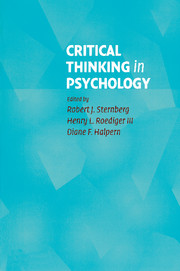Book contents
- Frontmatter
- Contents
- List of Illustrations and Tables
- List of Contributors
- Preface
- 1 The Nature and Nurture of Critical Thinking
- 2 Evaluating Experimental Research
- 3 Critical Thinking in Quasi-Experimentation
- 4 Evaluating Surveys and Questionnaires
- 5 Critical Thinking in Designing and Analyzing Research
- 6 The Case Study Perspective on Psychological Research
- 7 Informal Logical Fallacies
- 8 Designing Studies to Avoid Confounds
- 9 Evaluating Theories
- 10 Not All Experiments Are Created Equal
- 11 Making Claims in Papers and Talks
- 12 Critical Thinking in Clinical Inference
- 13 Evaluating Parapsychological Claims
- 14 Why Would Anyone Do or Believe Such a Thing?
- 15 The Belief Machine
- 16 Critical Thinking and Ethics in Psychology
- 17 Critical Thinking in Psychology
- Author Index
- Subject Index
- References
11 - Making Claims in Papers and Talks
Published online by Cambridge University Press: 05 June 2012
- Frontmatter
- Contents
- List of Illustrations and Tables
- List of Contributors
- Preface
- 1 The Nature and Nurture of Critical Thinking
- 2 Evaluating Experimental Research
- 3 Critical Thinking in Quasi-Experimentation
- 4 Evaluating Surveys and Questionnaires
- 5 Critical Thinking in Designing and Analyzing Research
- 6 The Case Study Perspective on Psychological Research
- 7 Informal Logical Fallacies
- 8 Designing Studies to Avoid Confounds
- 9 Evaluating Theories
- 10 Not All Experiments Are Created Equal
- 11 Making Claims in Papers and Talks
- 12 Critical Thinking in Clinical Inference
- 13 Evaluating Parapsychological Claims
- 14 Why Would Anyone Do or Believe Such a Thing?
- 15 The Belief Machine
- 16 Critical Thinking and Ethics in Psychology
- 17 Critical Thinking in Psychology
- Author Index
- Subject Index
- References
Summary
Getting stuff published is easier than getting people to read what you've published.
– Dennis ProffittINTRODUCTION
So, you've done some research and have some interesting results; perhaps you've even written drafts of your method and results sections. Now you have to write your introduction and discussion and figure out how to present your research to the world outside your lab. In addition to describing what you found, how are you going to frame the contribution of your research to psychology? In other words, what claims will you make?
This chapter is about how to make claims; that is, how to develop and communicate the sorts of arguments that make for informative, interesting, and persuasive papers and talks. In the first part of the chapter, we describe different types of claims and discuss how to assess your claim; that is, how to create an argument of “the right size.” In the second part, we discuss when and how to communicate your claim; that is, how to use the standard formats of papers and talks to your best advantage. Although we write in terms of empirical papers, these strategies are also relevant for review papers and talks. In the last part of the chapter, we offer tips specific to giving talks.
We believe that this chapter – focusing on the appropriate way to make research-based claims – will be of particular benefit to fledgling psychologists.
- Type
- Chapter
- Information
- Critical Thinking in Psychology , pp. 177 - 195Publisher: Cambridge University PressPrint publication year: 2006



